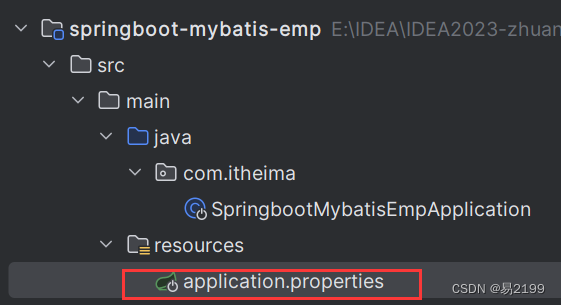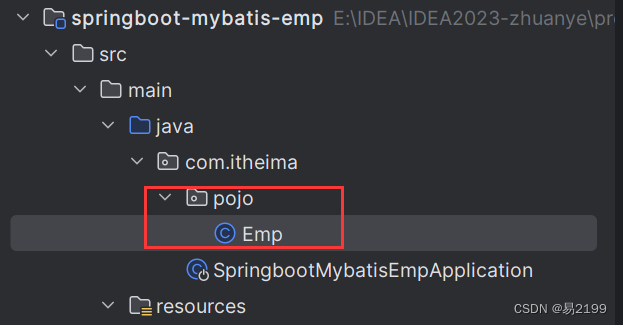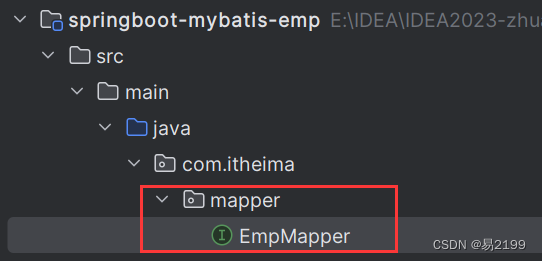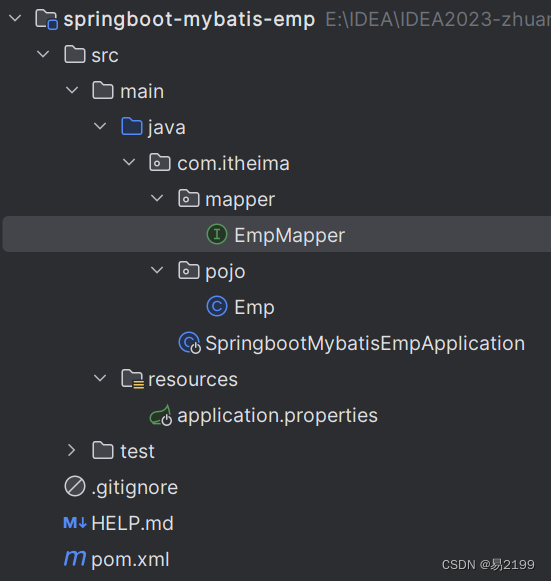黑马程序员JavaWeb开发教程
文章目录
- 根据资料中提供的《tlias智能学习辅助系统》页面原型及需求,完成员工管理的需求开发
- 一、环境准备
- 1、准备数据库表emp
- 2、创建一个新的springboot工程,选择引入对应的起步依赖(mybatis、mysql驱动、lombok)
- 3、application.properties中引入数据库连接信息
- 4、创建对应的实体类Emp(实体类属性采用驼峰命名)
- 5、准备Mapper接口EmpMApper
- 6、准备好的基础工程框架
- 二、基础操作-删除
- 1、根据主键ID删除
- 2、根据主键ID批量删除
- 三、基础操作-新增
- (1)SQL语句
- (2)Mapper接口
- (3)测试
- (4)主键返回
- 四、基础操作-更新
- (1)SQL语句
- (2)Mapper接口
- (3)测试
- 五、基础操作-查询
- 1、演示根据ID查询
- (1)SQL语句
- (2)Mapper接口
- (3)测试
- 2、出现问题
- 3、问题原因
- 4、解决方案
- 5、演示根据条件查询
- (1)SQL语句
- (2)Mapper接口
- (3)测试
根据资料中提供的《tlias智能学习辅助系统》页面原型及需求,完成员工管理的需求开发
一、环境准备
1、准备数据库表emp
- 创建表的sql语句
use mybatis;
-- 部门管理
create table dept(id int unsigned primary key auto_increment comment'ID,无符号整数,主键,自增长',name varchar(20) not null unique comment'部门名称,非空,唯一',create_time datetime not null comment'创建时间,非空',update_time datetime not null comment'修改时间,非空'
)comment '部门表';insert into dept (id, name, create_time, update_time)
values (1,'学工部',now(),now()),(2,'教研部',now(),now()),(3,'咨询部',now(),now()),(4,'就业部',now(),now()),(5,'人事部',now(),now());select * from dept;-- 员工管理
create table emp(id int unsigned primary key auto_increment comment'ID,无符号整数,主键,自增长',username varchar(20) not null unique comment'用户名,非空,唯一',password varchar(32) default '123456' comment'密码,默认123456',name varchar(10) not null comment'姓名,非空',gender tinyint unsigned not null comment '性别,无符号整数,,非空,1男,2女',image varchar(300) comment'图像',job tinyint unsigned comment'工作,无符号整数,1 班主任,2 讲师,3 学工主管, 4 教研主管,5 咨询师',entrydate date comment'入职时间',dept_id int unsigned comment'部门ID',create_time datetime not null comment'创建时间',update_time datetime not null comment'修改时间'
)comment'员工表';INSERT INTO emp(id, username, password, name, gender, image, job, entrydate,dept_id, create_time, update_time)
VALUES (1,'jinyong','123456','金庸',1,'1.jpg',4,'2000-01-01',2,now(),now()),(2,'zhangwuji','123456','张无忌',1,'2.jpg',2,'2015-01-01',2,now(),now()),(3,'yangxiao','123456','杨逍',1,'3.jpg',2,'2008-05-01',2,now(),now()),(4,'weiyixiao','123456','韦一笑',1,'4.jpg',2,'2007-01-01',2,now(),now()),(5,'changyuchun','123456','常遇春',1,'5.jpg',2,'2012-12-05',2,now(),now()),(6,'xiaozhao','123456','小昭',2,'6.jpg',3,'2013-09-05',1,now(),now()),(7,'jixiaofu','123456','纪晓芙',2,'7.jpg',1,'2005-08-01',1,now(),now()),(8,'zhouzhiruo','123456','周芷若',2,'8.jpg',1,'2014-11-09',1,now(),now()),(9,'dingminjun','123456','丁敏君',2,'9.jpg',1,'2011-03-11',1,now(),now()),(10,'zhaomin','123456','赵敏',2,'10.jpg',1,'2013-09-05',1,now(),now()),(11,'luzhangke','123456','鹿杖客',1,'11.jpg',5,'2007-02-01',3,now(),now()),(12,'hebiweng','123456','鹤笔翁',1,'12.jpg',5,'2008-08-18',3,now(),now()),(13,'fangdongbai','123456','方东白',1,'13.jpg',5,'2012-11-01',3,now(),now()),(14,'zhangsanfeng','123456','张三丰',1,'14.jpg',2,'2002-08-01',2,now(),now()),(15,'yulianzhou','123456','俞莲舟',1,'15.jpg',2,'2011-05-01',2,now(),now()),(16,'songyuanqiao','123456','宋远桥',1,'16.jpg',2,'2010-01-01',2,now(),now()),(17,'chenyouliang','123456','陈友谅',1,'17.jpg',NULL,'2015-03-21',NULL,now(),now());select * from emp;
2、创建一个新的springboot工程,选择引入对应的起步依赖(mybatis、mysql驱动、lombok)

3、application.properties中引入数据库连接信息
-
打开src.main.resources.application.properties,在其中填入配置数据库的信息

-
配置数据库的信息
# 配置数据库四要素#驱动类名称
spring.datasource.driver-class-name=com.mysql.cj.jdbc.Driver
#数据库连接的url(将数据库的名字mybatis修改成自己的数据库的名字)
spring.datasource.url=jdbc:mysql://localhost:3306/mybatis
#连接数据库的用户名(将用户名root修改成自己数据库的用户名)
spring.datasource.username=root
#连接数据库的密码(将密码123456修改成自己数据库的密码)
spring.datasource.password=123456
4、创建对应的实体类Emp(实体类属性采用驼峰命名)
-
在src.main.java.com.itheima 包下新建包pojo,并在pojo下新建类Emp

-
实体类属性和数据库中表的属性要同名,表中属性有下划线,实体类中使用驼峰命名即可
package com.itheima.pojo;import lombok.AllArgsConstructor;
import lombok.Data;
import lombok.NoArgsConstructor;import java.time.LocalDate;
import java.time.LocalDateTime;@Data
@AllArgsConstructor
@NoArgsConstructor
public class Emp {private Integer id; // IDprivate String username; // 用户名private String password; // 密码private String name; // 姓名private Short gender; // 性别,1 男,2 女private String image; // 图像urlprivate Short job; // 职位,说明:1 班主任,2 讲师,3 学工主管,4 教研主管,5 咨询师private LocalDate entrydate; // 入职日期private Integer deptId; // 部门idprivate LocalDateTime createTime; // 创建时间private LocalDateTime updateTime; // 修改时间
}5、准备Mapper接口EmpMApper
-
在src.main.java.com.itheima 包下新建包mapper,并在mapper下新建接口EmpMapper并加入@Mapper注解

-
EmpMapper接口中的代码
package com.itheima.mapper;import org.apache.ibatis.annotations.Mapper;@Mapper
public interface EmpMapper {
}6、准备好的基础工程框架

二、基础操作-删除
1、根据主键ID删除
- 接口 EmpMapper 中的代码
package com.itheima.mapper;import org.apache.ibatis.annotations.Delete;
import org.apache.ibatis.annotations.Mapper;@Mapper // 程序在运行时会自动创建改接口的代理对象,并且会将该代理对象放到IOC当中
public interface EmpMapper {//根据ID删除(一般都不需要返回值)@Delete("delete from emp where id=#{id}")public void deleteById(Integer id);
}- 测试类中的代码(src.test.java.com.itheima.SpringbootMybatisEmpApplicationTests)
package com.itheima;import com.itheima.mapper.EmpMapper;
import org.junit.jupiter.api.Test;
import org.springframework.beans.factory.annotation.Autowired;
import org.springframework.boot.test.context.SpringBootTest;@SpringBootTest
class SpringbootMybatisEmpApplicationTests {@Autowiredprivate EmpMapper empMapper;@Testpublic void deleteById() {empMapper.deleteById(17);}}- 注意事项:如果mapper接口方法形参只要有一个普通类型的参数,#{…}里面的属性名可以随便写,如:#{id}、#{value},但是为了增强可读性还是建议和参数名一样
2、根据主键ID批量删除
三、基础操作-新增
(1)SQL语句
- 正式开始之前,现根据要求将SQL语句写出来,插入的SQL语句如下
insert into emp(username,name,gender,image,job,entrydate,dept_id,create_time,update_time)
values('Tom','汤姆',1,'1.jpg',1,'2005-01-01',1,now(),now());
(2)Mapper接口
- 在EmpMapper接口中新增一个insert方法,使用 @Insert 注解将SQL语句传入,代码如下
//新增员工@Insert("insert into emp(username,name,gender,image,job,entrydate,dept_id,create_time,update_time)" +"values(#{username},#{name},#{gender},#{image},#{job},#{entrydate},#{deptId},#{createTime},#{updateTime})")public void insert(Emp emp);
(3)测试
- 在测试类中编写测试代码(src.test.java.com.itheima.SpringbootMybatisEmpApplicationTests)给Emp中的每个属性赋值
@Testpublic void testInsert() {// 构造员工对象Emp emp = new Emp();// 给员工对象赋值emp.setUsername("Tom");emp.setName("汤姆");emp.setImage("1.jpg");emp.setGender((short) 1);emp.setJob((short) 1);emp.setEntrydate(LocalDate.of(2000, 1, 1));emp.setCreateTime(LocalDateTime.now());emp.setUpdateTime(LocalDateTime.now());emp.setDeptId(1);// 测试empMapper.insert(emp);}(4)主键返回
-
描述:在数据添加成功后,需要获取插入数据库数据的主键
-
实现:@Options(useGeneratedKeys = true, keyProperty = “id”)

四、基础操作-更新
(1)SQL语句
- 根据要求编写用于更新的SQL语句
update emp set username='',name='',gender='',image='',job='',entrydate='',dept_id='',update_time='' where id=1;
(2)Mapper接口
- 新增一个修改员工信息的方法,并使用@Update注解将SQL语句传入
//修改员工信息@Update("update emp set username = #{username},name = #{name},gender = #{gender},image = #{image},job = #{job},entrydate = #{entrydate},dept_id = #{deptId},update_time = #{updateTime} where id = #{id}")public void update(Emp emp);
(3)测试
//测试修改员工信息@Testpublic void testUpdate() {// 构造员工对象Emp emp = new Emp();// 给员工对象赋值emp.setId(18);emp.setUsername("newTom");emp.setName("新汤姆");emp.setImage("1.jpg");emp.setGender((short) 1);emp.setJob((short) 1);emp.setEntrydate(LocalDate.of(2000, 1, 1));emp.setUpdateTime(LocalDateTime.now());emp.setDeptId(1);// 测试empMapper.update(emp);}五、基础操作-查询
1、演示根据ID查询
(1)SQL语句
select id, username, password, name, gender, image, job, entrydate, dept_id, create_time, update_time from emp where id=18;
或者
select * from emp where id=18;(2)Mapper接口
//根据ID查询员工信息@Select("select id, username, password, name, gender, image, job, entrydate, dept_id, create_time, update_time from emp where id=#{id}")public Emp getEmpById(Integer id);
(3)测试
@Testpublic void testGetEmpById(){Emp emp = empMapper.getEmpById(18);System.out.println(emp);}
2、出现问题
- 可以看到返回值如下,其中 deptId=null, createTime=null, updateTime=null
Emp(id=18, username=newTom, password=123456, name=新汤姆, gender=1, image=1.jpg, job=1, entrydate=2000-01-01, deptId=null, createTime=null, updateTime=null)
3、问题原因
- 实体类属性名 和 数据库表查询返回的字段名一致,mybatis会自动封装
- 如果实体类属性名 和 数据库表查询返回的字段名不一致,不能自动封装
4、解决方案
- 方案一:起别名,在SQL语句中,UI不一样的列名其别名,别名和实体类属性名一样
//方案一:起别名@Select("select id, username, password, name, gender, image, job, entrydate, dept_id as deptId, create_time as createTime, update_time as updateTime from emp where id = #{id}")public Emp getEmpById(Integer id);
- 方案二:手动结果映射,通过@Results以及@Result进行手动结果映射
@Results({@Result(column = "dept_id",property = "deptId"),@Result(column = "create_time",property = "createTime"),@Result(column = "update_time",property = "updateTime")})@Select("select id, username, password, name, gender, image, job, entrydate, dept_id, create_time,update_time from emp where id = #{id}")public Emp getEmpById(Integer id);- 方案三:开启驼峰命名,如果字段名与属性名符合驼峰命名规则,mybatis会自动通过驼峰命名规则映射
注意:前提是数据库中的一下划线分割,实体类中是驼峰命名才可以使用这个解决方案,同时这也是推荐的解决方案- 首先在src.main.resources.application.properties配置文件中加入:
# 开启 mybatis驼峰命名的映射
mybatis.configuration.map-underscore-to-camel-case=true
-
- 之后就可以像之前一样直接写
// 方案三@Select("select id, username, password, name, gender, image, job, entrydate, dept_id, create_time,update_time from emp where id = #{id}")public Emp getEmpById(Integer id);
5、演示根据条件查询

(1)SQL语句
select * from emp where name like'%张%' and gender='' and entrydate between '' and '' order by update_time desc;(2)Mapper接口
- 不知道为什么使用的是2.X也需要加@Param注解
//条件查询@Select("select * from emp where name like concat('%',#{name},'%') and gender=#{gender} and " +"entrydate between #{begin} and #{end} order by update_time desc")public List<Emp> list(@Param("name") String name, @Param("gender") Short gender, @Param("begin") LocalDate begin, @Param("end") LocalDate end);
(3)测试
@Test
public void testList(){
List list = empMapper.list(“张”, (short) 1, LocalDate.of(2010, 1, 1), LocalDate.of(2020, 1, 1));
System.out.println(list);
}












和射频直接带通采样定理(盲区采样定理))
)




)
